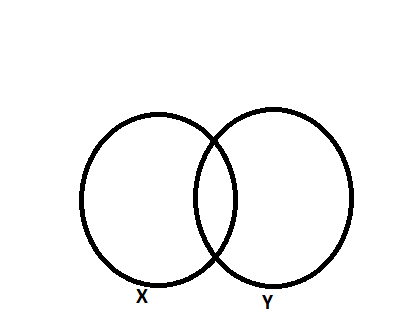Question
Question: If events A and B are independent and \(P\left( A \right)=0.15,\,\,P\left( A\cup B \right)=0.45\), t...
If events A and B are independent and P(A)=0.15,P(A∪B)=0.45, then P(B) is:
(a) 136
(b) 176
(c) 196
(d) 236
Solution
Hint: Use the given condition to find the value of intersection of events A, B. Now draw Venn diagrams of two events X, Y. Then derive a formula for their union. Try to relate union, intersection and the two events themselves for this formula. Now substitute all the values you have. Then you will be left with a single variable P(B). Now keep this P(B) variable term on the left-hand side and send all other constants on to the right-hand side. By this, after all simplification the values on the right hand side will be our required result that is the value of P(B).
Complete step-by-step answer:
Venn Diagram: A Venn diagram is a diagram that shows all possible logical relations between a collection of different sets. These diagrams depict elements as points in a space, and as set as regions inside a closed curve generally circles. Each circle represents a set. The overlapping region represents the common points between sets.
Intersection of sets: In mathematics, intersection of 2 sets A, B is the set consisting of all elements common in both A, B denoted by A∩B.
Union of sets: In mathematics, union of 2 sets A, B is the set consisting of all elements belonging to A, B denoted by A∪B.
Let us take any two random events X, Y.
Let us assume the probability of events X is P(X).
Let us assume the probability of event y is P(Y).
Let us assume intersection of events as P(X∩Y)
Let us assume union of events as P(X∪Y)

First Venn diagram is representation of X and the second Venn diagram is representation of the event y.
By the diagram, when we combine both X and Y events, we count the intersection part twice. So, we need to subtract the intersection term once to get the union. So, we can write it as:
P(X∪Y)=P(X)+P(Y)−P(X∩Y)
It is given in the question they are independent, so, we say:
P(A∩B)=P(A)×P(B)
Given in the question the values of few terms, we get:
P(A∪B)=0.45,P(A)=0.15
By substituting events A, B into union formula, we get:
P(A∪B)=P(A)+P(B)−P(A∩B)
By substituting the value of P(A∩B) in the equation, we get:
P(A∪B)=P(A)+P(B)−P(A)×P(B)
By substituting the values, you know, we get it as:
0.45=0.15+P(B)−0.15P(B)
So, simplifying, we get P(B) value, as below:
P(B)=2530=176
Therefore option (b) is the correct answer for the given question.
Note: Generally, students confuse and take P(A∩B)=0 when they are all independent but it is a wrong method. You must always take P(A∩B)=P(A)+P(B). While substituting don’t forget the term P(B) generated by intersection probability. Students forget that term and solve where they get the wrong result. So, solve it carefully.
